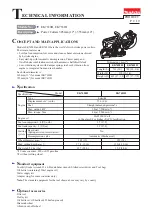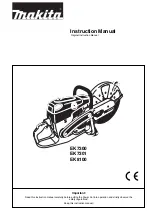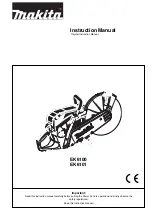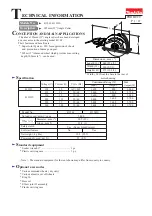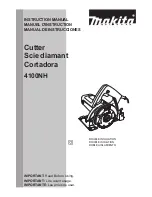
CONSIGNES GÉNÉRALES DE SÉCURITÉ
d) Si la scie tombe, la course de plongée peut être
endommagée. Effectuez la coupe en plongée et ramenez
la scie en position verticale. Assurez-vous que la scie bouge
librement et qu’elle ne touche pas le boîtier ni toute autre
pièce, quels que soient l’angle et la profondeur de coupe.
e) Cette scie est équipée d’un couteau diviseur qui s’étend
automatiquement avec la lame. Le couteau diviseur est
un élément important de la protection anti-rebond. Vérifiez-
le régulièrement pour vous assurer qu’il fonctionne librement.
Si vous avez des préoccupations concernant le
fonctionnement du couteau diviseur, n’utilisez pas la scie.
f) Faites toujours vos coupes en vous assurant que la pièce à
travailler se trouve sous le guide sur rail, et que la sciure est
évacuée vers l’extérieur.
g) Pour les coupes de moins de 10,16 cm de largeur, soutenez
le guide sur rail avec des retailles de la même épaisseur que
la pièce à travailler.
h) Éloignez vos mains de la zone de coupe et de la lame.
Gardez votre deuxième main sur la poignée avant.
En tenant la scie à deux mains, vous ne vous couperez pas
avec la lame.
i) Tenez l’outil par la poignée isolée lors des opérations au cours
desquelles il est susceptible d’entrer en contact avec des fils
dissimulés ou avec son propre cordon. Si l’outil entre en
contact avec un fil sous tension, cela risque de mettre
également sous tension les pièces métalliques exposées
de l’outil électrique et d’occasionner un choc électrique
à l’utilisateur.
j) Placez votre corps d’un côté ou de l’autre de la lame, mais
jamais devant ou derrière la lame. Des rebonds pourraient
faire reculer la scie. (
Voir le rebond dans la section
CONSIGNES DE SÉCURITÉ POUR TOUTES LES
SCIES ci-dessus.
)
k) Vérifiez toujours que la lame est complètement rétractée
dans le boîtier avant de déposer la scie sur le banc ou au
sol. Une lame non protégée qui tourne toujours peut faire
reculer la scie, en coupant tout sur son passage. Faites
attention au temps qu’il faut à la lame pour s’immobiliser
après avoir relâché l’interrupteur.
l) N’utilisez qu’une lame d’un diamètre de 165 mm (6½ po) avec
un alésage central de 20 mm. Les lames qui ne
correspondent pas à la quincaillerie de fixation de la scie
fonctionnent de façon imprévisible et entraînent des pertes
de contrôle.
m) Utilisez uniquement une lame d’une vitesse de rotation
minimale de 7 000 tours/minute.
n) Utilisez uniquement une lame dont l’épaisseur du corps
de la lame est inférieure à 2,0 mm et la denture de la lame est
supérieure à 2,0 mm
o) N’utilisez jamais de rondelles de pale ou de boulons
endommagés ou inadéquats. Les rondelles de pale et les
boulons ont été spécialement conçus pour votre scie afin
d’en assurer un rendement optimal et un fonctionnement
sécuritaire.
p) N’utilisez pas cette scie avec une meule abrasive.
q) Cette scie est destinée uniquement à la coupe de bois et
de produits en bois. Ne coupez pas de métal, de matériaux de
maçonnerie, de verre, de planches de type maçonné,
de panneaux en fibrociment, de carreaux ou de plastique
avec cette scie.
r) Assurez-vous que le couteau diviseur est réglé de sorte que la
distance entre le couteau et le bord de la lame soit d’un
maximum de 5 mm, et que le bord de la lame ne dépasse pas
de plus de 5 mm du rebord inférieur du couteau.
s) Un sac à poussière ou un tuyau de dépoussiérage doit être
installé sur l’orifice de récupération avant d’utiliser la scie.
!
symbole d’alerte de sécurité
V volts
Hz
hertz
A ampères
W watts
courant continu
English
3
• Be sure that the cutter knives are mounted as described in the
instruction manual and check that all bolts are firmly tightened
before connecting unit to power source.
• To avoid injury, never rotate the cutter block directly with your
hands.
• Keep guards in place and in good working order.
• Stay alert – never operate the unit when tired or under the
influence of drugs, alcohol, or medication.
• Do not use in dangerous environments. Do not use near
flammable substances, in damp or wet locations, or expose to
rain.
• Never plane material which is shorter than 12 inches.
• Exhaust chute: remove shavings with brush or vacuum after
power has been shut off and cutter head has stopped rotating.
• ALWAYS LOCATE PLANER WITH PROPER CLEARANCE ON
THE OUTFEED SIDE of the unit to prevent pinching or binding of
the workpiece against any obstacle.
•
Clean out your tool often, especially after heavy use.
Dust
and grit containing metal particles often accumulate on interior
surfaces and could create a risk of serious injury, electric shock or
electrocution. ALWAYS WEAR SAFETY GLASSES.
WARNING:
For your own safety, it is recommended that two
people carry this machine or serious injury could result.
WARNING: Always wear proper personal hearing protection
that conforms to ANSI S12.6 (S3.19) during use.
Under some
conditions and duration of use, noise from this product may
contribute to hearing loss.
WARNING:
Some dust created by power sanding, sawing,
grinding, drilling, and other construction activities contains chemicals
known to the State of California to cause cancer, birth defects or
other reproductive harm. Some examples of these chemicals are:
• lead from lead-based paints,
•
crystalline silica from bricks and cement and other masonry
products, and
• arsenic and chromium from chemically-treated lumber.
Your risk from these exposures varies, depending on how often you
do this type of work. To reduce your exposure to these chemicals:
work in a well ventilated area, and work with approved safety
equipment, such as those dust masks that are specially designed to
filter out microscopic particles.
•
Avoid prolonged contact with dust from power sanding,
sawing, grinding, drilling, and other construction activities.
Wear protective clothing and wash exposed areas with
soap and water.
Allowing dust to get into your mouth, eyes, or
lay on the skin may promote absorption of harmful chemicals.
WARNING:
A dust mask or respirator should be worn by all
persons entering the work area. The filter should be replaced daily or
whenever the wearer has difficulty breathing. See your local hardware
store for the proper NIOSH/OSHA approved dust mask.
• The label on your tool may include the following symbols. The
symbols and their definitions are as follows:
V ......... volts
A .......amperes
Hz ....... hertz
W ......watts
min ..... minutes
.....alternating current
... direct current
.....alternating or direct current
....... Class I Construction
no ......no load speed
...........
(grounded)
......earthing terminal
....... Class II Construction
.....safety alert symbol
...........
(double insulated)
BPM ..beats per minute
…/min per minute
RPM ..revolutions per minute
courant alternatif
English
3
• Be sure that the cutter knives are mounted as described in the
instruction manual and check that all bolts are firmly tightened
before connecting unit to power source.
• To avoid injury, never rotate the cutter block directly with your
hands.
• Keep guards in place and in good working order.
• Stay alert – never operate the unit when tired or under the
influence of drugs, alcohol, or medication.
• Do not use in dangerous environments. Do not use near
flammable substances, in damp or wet locations, or expose to
rain.
• Never plane material which is shorter than 12 inches.
• Exhaust chute: remove shavings with brush or vacuum after
power has been shut off and cutter head has stopped rotating.
• ALWAYS LOCATE PLANER WITH PROPER CLEARANCE ON
THE OUTFEED SIDE of the unit to prevent pinching or binding of
the workpiece against any obstacle.
•
Clean out your tool often, especially after heavy use.
Dust
and grit containing metal particles often accumulate on interior
surfaces and could create a risk of serious injury, electric shock or
electrocution. ALWAYS WEAR SAFETY GLASSES.
WARNING:
For your own safety, it is recommended that two
people carry this machine or serious injury could result.
WARNING: Always wear proper personal hearing protection
that conforms to ANSI S12.6 (S3.19) during use.
Under some
conditions and duration of use, noise from this product may
contribute to hearing loss.
WARNING:
Some dust created by power sanding, sawing,
grinding, drilling, and other construction activities contains chemicals
known to the State of California to cause cancer, birth defects or
other reproductive harm. Some examples of these chemicals are:
• lead from lead-based paints,
•
crystalline silica from bricks and cement and other masonry
products, and
• arsenic and chromium from chemically-treated lumber.
Your risk from these exposures varies, depending on how often you
do this type of work. To reduce your exposure to these chemicals:
work in a well ventilated area, and work with approved safety
equipment, such as those dust masks that are specially designed to
filter out microscopic particles.
•
Avoid prolonged contact with dust from power sanding,
sawing, grinding, drilling, and other construction activities.
Wear protective clothing and wash exposed areas with
soap and water.
Allowing dust to get into your mouth, eyes, or
lay on the skin may promote absorption of harmful chemicals.
WARNING:
A dust mask or respirator should be worn by all
persons entering the work area. The filter should be replaced daily or
whenever the wearer has difficulty breathing. See your local hardware
store for the proper NIOSH/OSHA approved dust mask.
• The label on your tool may include the following symbols. The
symbols and their definitions are as follows:
V ......... volts
A .......amperes
Hz ....... hertz
W ......watts
min ..... minutes
.....alternating current
... direct current
.....alternating or direct current
....... Class I Construction
no ......no load speed
...........
(grounded)
......earthing terminal
....... Class II Construction
.....safety alert symbol
...........
(double insulated)
BPM ..beats per minute
…/min per minute
RPM ..revolutions per minute
courant alternatif ou continu
English
3
• Be sure that the cutter knives are mounted as described in the
instruction manual and check that all bolts are firmly tightened
before connecting unit to power source.
• To avoid injury, never rotate the cutter block directly with your
hands.
• Keep guards in place and in good working order.
• Stay alert – never operate the unit when tired or under the
influence of drugs, alcohol, or medication.
• Do not use in dangerous environments. Do not use near
flammable substances, in damp or wet locations, or expose to
rain.
• Never plane material which is shorter than 12 inches.
• Exhaust chute: remove shavings with brush or vacuum after
power has been shut off and cutter head has stopped rotating.
• ALWAYS LOCATE PLANER WITH PROPER CLEARANCE ON
THE OUTFEED SIDE of the unit to prevent pinching or binding of
the workpiece against any obstacle.
•
Clean out your tool often, especially after heavy use.
Dust
and grit containing metal particles often accumulate on interior
surfaces and could create a risk of serious injury, electric shock or
electrocution. ALWAYS WEAR SAFETY GLASSES.
WARNING:
For your own safety, it is recommended that two
people carry this machine or serious injury could result.
WARNING: Always wear proper personal hearing protection
that conforms to ANSI S12.6 (S3.19) during use.
Under some
conditions and duration of use, noise from this product may
contribute to hearing loss.
WARNING:
Some dust created by power sanding, sawing,
grinding, drilling, and other construction activities contains chemicals
known to the State of California to cause cancer, birth defects or
other reproductive harm. Some examples of these chemicals are:
• lead from lead-based paints,
•
crystalline silica from bricks and cement and other masonry
products, and
• arsenic and chromium from chemically-treated lumber.
Your risk from these exposures varies, depending on how often you
do this type of work. To reduce your exposure to these chemicals:
work in a well ventilated area, and work with approved safety
equipment, such as those dust masks that are specially designed to
filter out microscopic particles.
•
Avoid prolonged contact with dust from power sanding,
sawing, grinding, drilling, and other construction activities.
Wear protective clothing and wash exposed areas with
soap and water.
Allowing dust to get into your mouth, eyes, or
lay on the skin may promote absorption of harmful chemicals.
WARNING:
A dust mask or respirator should be worn by all
persons entering the work area. The filter should be replaced daily or
whenever the wearer has difficulty breathing. See your local hardware
store for the proper NIOSH/OSHA approved dust mask.
• The label on your tool may include the following symbols. The
symbols and their definitions are as follows:
V ......... volts
A .......amperes
Hz ....... hertz
W ......watts
min ..... minutes
.....alternating current
... direct current
.....alternating or direct current
....... Class I Construction
no ......no load speed
...........
(grounded)
......earthing terminal
....... Class II Construction
.....safety alert symbol
...........
(double insulated)
BPM ..beats per minute
…/min per minute
RPM ..revolutions per minute
appareil de classe I (mis à la terre)
English
3
• Be sure that the cutter knives are mounted as described in the
instruction manual and check that all bolts are firmly tightened
before connecting unit to power source.
• To avoid injury, never rotate the cutter block directly with your
hands.
• Keep guards in place and in good working order.
• Stay alert – never operate the unit when tired or under the
influence of drugs, alcohol, or medication.
• Do not use in dangerous environments. Do not use near
flammable substances, in damp or wet locations, or expose to
rain.
• Never plane material which is shorter than 12 inches.
• Exhaust chute: remove shavings with brush or vacuum after
power has been shut off and cutter head has stopped rotating.
• ALWAYS LOCATE PLANER WITH PROPER CLEARANCE ON
THE OUTFEED SIDE of the unit to prevent pinching or binding of
the workpiece against any obstacle.
•
Clean out your tool often, especially after heavy use.
Dust
and grit containing metal particles often accumulate on interior
surfaces and could create a risk of serious injury, electric shock or
electrocution. ALWAYS WEAR SAFETY GLASSES.
WARNING:
For your own safety, it is recommended that two
people carry this machine or serious injury could result.
WARNING: Always wear proper personal hearing protection
that conforms to ANSI S12.6 (S3.19) during use.
Under some
conditions and duration of use, noise from this product may
contribute to hearing loss.
WARNING:
Some dust created by power sanding, sawing,
grinding, drilling, and other construction activities contains chemicals
known to the State of California to cause cancer, birth defects or
other reproductive harm. Some examples of these chemicals are:
• lead from lead-based paints,
•
crystalline silica from bricks and cement and other masonry
products, and
• arsenic and chromium from chemically-treated lumber.
Your risk from these exposures varies, depending on how often you
do this type of work. To reduce your exposure to these chemicals:
work in a well ventilated area, and work with approved safety
equipment, such as those dust masks that are specially designed to
filter out microscopic particles.
•
Avoid prolonged contact with dust from power sanding,
sawing, grinding, drilling, and other construction activities.
Wear protective clothing and wash exposed areas with
soap and water.
Allowing dust to get into your mouth, eyes, or
lay on the skin may promote absorption of harmful chemicals.
WARNING:
A dust mask or respirator should be worn by all
persons entering the work area. The filter should be replaced daily or
whenever the wearer has difficulty breathing. See your local hardware
store for the proper NIOSH/OSHA approved dust mask.
• The label on your tool may include the following symbols. The
symbols and their definitions are as follows:
V ......... volts
A .......amperes
Hz ....... hertz
W ......watts
min ..... minutes
.....alternating current
... direct current
.....alternating or direct current
....... Class I Construction
no ......no load speed
...........
(grounded)
......earthing terminal
....... Class II Construction
.....safety alert symbol
...........
(double insulated)
BPM ..beats per minute
…/min per minute
RPM ..revolutions per minute
outil de catégorie II
(double isolation)
English
3
• Be sure that the cutter knives are mounted as described in the
instruction manual and check that all bolts are firmly tightened
before connecting unit to power source.
• To avoid injury, never rotate the cutter block directly with your
hands.
• Keep guards in place and in good working order.
• Stay alert – never operate the unit when tired or under the
influence of drugs, alcohol, or medication.
• Do not use in dangerous environments. Do not use near
flammable substances, in damp or wet locations, or expose to
rain.
• Never plane material which is shorter than 12 inches.
• Exhaust chute: remove shavings with brush or vacuum after
power has been shut off and cutter head has stopped rotating.
• ALWAYS LOCATE PLANER WITH PROPER CLEARANCE ON
THE OUTFEED SIDE of the unit to prevent pinching or binding of
the workpiece against any obstacle.
•
Clean out your tool often, especially after heavy use.
Dust
and grit containing metal particles often accumulate on interior
surfaces and could create a risk of serious injury, electric shock or
electrocution. ALWAYS WEAR SAFETY GLASSES.
WARNING:
For your own safety, it is recommended that two
people carry this machine or serious injury could result.
WARNING: Always wear proper personal hearing protection
that conforms to ANSI S12.6 (S3.19) during use.
Under some
conditions and duration of use, noise from this product may
contribute to hearing loss.
WARNING:
Some dust created by power sanding, sawing,
grinding, drilling, and other construction activities contains chemicals
known to the State of California to cause cancer, birth defects or
other reproductive harm. Some examples of these chemicals are:
• lead from lead-based paints,
•
crystalline silica from bricks and cement and other masonry
products, and
• arsenic and chromium from chemically-treated lumber.
Your risk from these exposures varies, depending on how often you
do this type of work. To reduce your exposure to these chemicals:
work in a well ventilated area, and work with approved safety
equipment, such as those dust masks that are specially designed to
filter out microscopic particles.
•
Avoid prolonged contact with dust from power sanding,
sawing, grinding, drilling, and other construction activities.
Wear protective clothing and wash exposed areas with
soap and water.
Allowing dust to get into your mouth, eyes, or
lay on the skin may promote absorption of harmful chemicals.
WARNING:
A dust mask or respirator should be worn by all
persons entering the work area. The filter should be replaced daily or
whenever the wearer has difficulty breathing. See your local hardware
store for the proper NIOSH/OSHA approved dust mask.
• The label on your tool may include the following symbols. The
symbols and their definitions are as follows:
V ......... volts
A .......amperes
Hz ....... hertz
W ......watts
min ..... minutes
.....alternating current
... direct current
.....alternating or direct current
....... Class I Construction
no ......no load speed
...........
(grounded)
......earthing terminal
....... Class II Construction
.....safety alert symbol
...........
(double insulated)
BPM ..beats per minute
…/min per minute
RPM ..revolutions per minute
borne de mise à la terre
min minutes
/min
tours ou va-et-vient par minute
BPM
battements par minute
RPM
tours par minute
English
3
• Be sure that the cutter knives are mounted as described in the
instruction manual and check that all bolts are firmly tightened
before connecting unit to power source.
• To avoid injury, never rotate the cutter block directly with your
hands.
• Keep guards in place and in good working order.
• Stay alert – never operate the unit when tired or under the
influence of drugs, alcohol, or medication.
• Do not use in dangerous environments. Do not use near
flammable substances, in damp or wet locations, or expose to
rain.
• Never plane material which is shorter than 12 inches.
• Exhaust chute: remove shavings with brush or vacuum after
power has been shut off and cutter head has stopped rotating.
• ALWAYS LOCATE PLANER WITH PROPER CLEARANCE ON
THE OUTFEED SIDE of the unit to prevent pinching or binding of
the workpiece against any obstacle.
•
Clean out your tool often, especially after heavy use.
Dust
and grit containing metal particles often accumulate on interior
surfaces and could create a risk of serious injury, electric shock or
electrocution. ALWAYS WEAR SAFETY GLASSES.
WARNING:
For your own safety, it is recommended that two
people carry this machine or serious injury could result.
WARNING: Always wear proper personal hearing protection
that conforms to ANSI S12.6 (S3.19) during use.
Under some
conditions and duration of use, noise from this product may
contribute to hearing loss.
WARNING:
Some dust created by power sanding, sawing,
grinding, drilling, and other construction activities contains chemicals
known to the State of California to cause cancer, birth defects or
other reproductive harm. Some examples of these chemicals are:
• lead from lead-based paints,
•
crystalline silica from bricks and cement and other masonry
products, and
• arsenic and chromium from chemically-treated lumber.
Your risk from these exposures varies, depending on how often you
do this type of work. To reduce your exposure to these chemicals:
work in a well ventilated area, and work with approved safety
equipment, such as those dust masks that are specially designed to
filter out microscopic particles.
•
Avoid prolonged contact with dust from power sanding,
sawing, grinding, drilling, and other construction activities.
Wear protective clothing and wash exposed areas with
soap and water.
Allowing dust to get into your mouth, eyes, or
lay on the skin may promote absorption of harmful chemicals.
WARNING:
A dust mask or respirator should be worn by all
persons entering the work area. The filter should be replaced daily or
whenever the wearer has difficulty breathing. See your local hardware
store for the proper NIOSH/OSHA approved dust mask.
• The label on your tool may include the following symbols. The
symbols and their definitions are as follows:
V ......... volts
A .......amperes
Hz ....... hertz
W ......watts
min ..... minutes
.....alternating current
... direct current
.....alternating or direct current
....... Class I Construction
no ......no load speed
...........
(grounded)
......earthing terminal
....... Class II Construction
.....safety alert symbol
...........
(double insulated)
BPM ..beats per minute
…/min per minute
RPM ..revolutions per minute
vitesse sans charge
Lire les instructions
Porter des lunettes de sécurité et des
protecteurs auditifs
Éloigner vos mains et votre corps de la lame,
en restant sur le côté. Tout contact avec la
lame peut causer des blessures graves.
Mode de changement de lame
Mode Coupe
Conditions et définitions
Les symboles suivants peuvent figurer sur l’étiquette de votre scie.
Les symboles et leurs définitions sont les suivants :
Содержание ADAPTIVE CUTTING SYSTEM
Страница 79: ...NOTES REMARQUES NOTAS ...
































